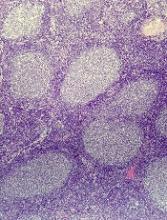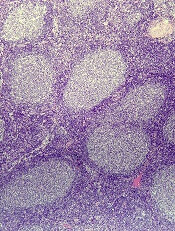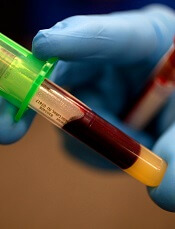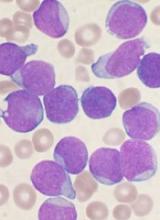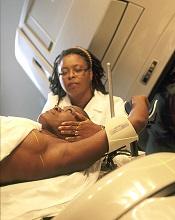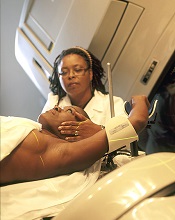User login
Drug receives fast track designation for follicular lymphoma
The US Food and Drug Administration (FDA) has granted fast track designation to the EZH2 inhibitor tazemetostat as a treatment for relapsed or refractory follicular lymphoma, with or without EZH2-activating mutations.
The FDA’s fast track program is designed to facilitate the development and expedite the review of products intended to treat or prevent serious or life-threatening conditions and address unmet medical need.
Through the fast track program, a product may be eligible for priority review.
In addition, the company developing the product may be allowed to submit sections of the new drug application or biologic license application on a rolling basis as data become available.
Fast track designation also provides the company with opportunities for more frequent meetings and written communications with the FDA.
Tazemetostat also has fast track designation from the FDA as a treatment for patients with relapsed or refractory diffuse large B-cell lymphoma (DLBCL) with EZH2-activating mutations.
Tazemetostat is under investigation as monotherapy and in combination with other agents as a treatment for multiple cancers.
Results from a phase 1 study suggested tazemetostat can produce durable responses in patients with advanced non-Hodgkin lymphomas, including follicular lymphoma and DLBCL. The study was presented at the 2015 ASH Annual Meeting.
Tazemetostat is currently under investigation in a phase 2 trial of adults with relapsed or refractory DLBCL or follicular lymphoma.
Interim efficacy and safety data from this study are scheduled to be presented at the International Conference on Malignant Lymphoma (ICML) in Lugano, Switzerland, on June 14, 2017, at 2:00 pm CET.
Tazemetostat is being developed by Epizyme, Inc. ![]()
The US Food and Drug Administration (FDA) has granted fast track designation to the EZH2 inhibitor tazemetostat as a treatment for relapsed or refractory follicular lymphoma, with or without EZH2-activating mutations.
The FDA’s fast track program is designed to facilitate the development and expedite the review of products intended to treat or prevent serious or life-threatening conditions and address unmet medical need.
Through the fast track program, a product may be eligible for priority review.
In addition, the company developing the product may be allowed to submit sections of the new drug application or biologic license application on a rolling basis as data become available.
Fast track designation also provides the company with opportunities for more frequent meetings and written communications with the FDA.
Tazemetostat also has fast track designation from the FDA as a treatment for patients with relapsed or refractory diffuse large B-cell lymphoma (DLBCL) with EZH2-activating mutations.
Tazemetostat is under investigation as monotherapy and in combination with other agents as a treatment for multiple cancers.
Results from a phase 1 study suggested tazemetostat can produce durable responses in patients with advanced non-Hodgkin lymphomas, including follicular lymphoma and DLBCL. The study was presented at the 2015 ASH Annual Meeting.
Tazemetostat is currently under investigation in a phase 2 trial of adults with relapsed or refractory DLBCL or follicular lymphoma.
Interim efficacy and safety data from this study are scheduled to be presented at the International Conference on Malignant Lymphoma (ICML) in Lugano, Switzerland, on June 14, 2017, at 2:00 pm CET.
Tazemetostat is being developed by Epizyme, Inc. ![]()
The US Food and Drug Administration (FDA) has granted fast track designation to the EZH2 inhibitor tazemetostat as a treatment for relapsed or refractory follicular lymphoma, with or without EZH2-activating mutations.
The FDA’s fast track program is designed to facilitate the development and expedite the review of products intended to treat or prevent serious or life-threatening conditions and address unmet medical need.
Through the fast track program, a product may be eligible for priority review.
In addition, the company developing the product may be allowed to submit sections of the new drug application or biologic license application on a rolling basis as data become available.
Fast track designation also provides the company with opportunities for more frequent meetings and written communications with the FDA.
Tazemetostat also has fast track designation from the FDA as a treatment for patients with relapsed or refractory diffuse large B-cell lymphoma (DLBCL) with EZH2-activating mutations.
Tazemetostat is under investigation as monotherapy and in combination with other agents as a treatment for multiple cancers.
Results from a phase 1 study suggested tazemetostat can produce durable responses in patients with advanced non-Hodgkin lymphomas, including follicular lymphoma and DLBCL. The study was presented at the 2015 ASH Annual Meeting.
Tazemetostat is currently under investigation in a phase 2 trial of adults with relapsed or refractory DLBCL or follicular lymphoma.
Interim efficacy and safety data from this study are scheduled to be presented at the International Conference on Malignant Lymphoma (ICML) in Lugano, Switzerland, on June 14, 2017, at 2:00 pm CET.
Tazemetostat is being developed by Epizyme, Inc. ![]()
Treatment granted PRIME designation for hemophilia B
The European Medicines Agency (EMA) has granted AMT-060 access to the agency’s PRIority MEdicines (PRIME) program.
AMT-060 is an investigational gene therapy intended for the treatment of patients with severe hemophilia B.
The goal of the EMA’s PRIME program is to accelerate the development of therapies that may offer a major advantage over existing treatments or benefit patients with no treatment options.
Through PRIME, the EMA offers early and enhanced support to developers in order to optimize development plans and speed regulatory evaluations to potentially bring therapies to patients more quickly.
To be accepted for PRIME, a therapy must demonstrate the potential to benefit patients with unmet medical need through early clinical or nonclinical data.
About AMT-060
AMT-060 consists of a codon-optimized wild-type factor IX (FIX) gene cassette, the LP1 liver promoter, and an AAV5 viral vector manufactured by uniQure using its proprietary insect cell-based technology platform. UniQure is the company developing AMT-060.
The EMA’s decision to grant AMT-060 access to the PRIME program is based on results from an ongoing phase 1/2 study. Updated data from this study were presented at the 2016 ASH Annual Meeting (abstract 2314).
The presentation included data on 10 patients. All patients had severe or moderately severe hemophilia at baseline, including documented FIX levels less than 1% to 2% of normal, and required chronic infusions of prophylactic or on-demand FIX therapy at the time of enrollment.
Each patient received a 1-time, 30-minute, intravenous dose of AMT-060, without the use of corticosteroids. Five patients received AMT-060 at 5 x 1012 gc/kg, and 5 received AMT-060 at 2 x 1013 gc/kg.
Patients in the low-dose cohort were followed for up to 52 weeks, and those in the higher-dose cohort were followed for up to 31 weeks.
Data from the higher-dose cohort showed a dose response with improvement in disease state in all 5 patients. Four patients who previously required prophylactic FIX therapy were able to stop this therapy.
As of the data cutoff date, 1 unconfirmed spontaneous bleed had been reported during an aggregate of 94 weeks of follow-up after the discontinuation of prophylaxis.
Researchers previously reported that 4 patients in the low-dose cohort were able to discontinue prophylactic therapy. The 1 patient who remained on prophylaxis sustained an improved disease phenotype and also required materially less FIX concentrate after treatment with AMT-060.
According to uniQure, all 5 patients in the low-dose cohort maintained “constant and clinically meaningful” levels of FIX activity for up to 52 weeks post-treatment. In fact, there were no spontaneous bleeds in these patients in the last 14 weeks of observation.
uniQure also said AMT-060 was well-tolerated, and there have been no severe adverse events.
Three patients (2 in the higher-dose cohort and 1 previously reported from the low-dose cohort) experienced mild, asymptomatic elevations of alanine aminotransferase and received a tapering course of corticosteroids per protocol.
These temporary alanine aminotransferase elevations were not associated with any loss of endogenous FIX activity or T-cell response to the AAV5 capsid.
None of the patients in either cohort have developed inhibitory antibodies against FIX, and none of the patients screened tested positive for anti-AAV5 antibodies. ![]()
The European Medicines Agency (EMA) has granted AMT-060 access to the agency’s PRIority MEdicines (PRIME) program.
AMT-060 is an investigational gene therapy intended for the treatment of patients with severe hemophilia B.
The goal of the EMA’s PRIME program is to accelerate the development of therapies that may offer a major advantage over existing treatments or benefit patients with no treatment options.
Through PRIME, the EMA offers early and enhanced support to developers in order to optimize development plans and speed regulatory evaluations to potentially bring therapies to patients more quickly.
To be accepted for PRIME, a therapy must demonstrate the potential to benefit patients with unmet medical need through early clinical or nonclinical data.
About AMT-060
AMT-060 consists of a codon-optimized wild-type factor IX (FIX) gene cassette, the LP1 liver promoter, and an AAV5 viral vector manufactured by uniQure using its proprietary insect cell-based technology platform. UniQure is the company developing AMT-060.
The EMA’s decision to grant AMT-060 access to the PRIME program is based on results from an ongoing phase 1/2 study. Updated data from this study were presented at the 2016 ASH Annual Meeting (abstract 2314).
The presentation included data on 10 patients. All patients had severe or moderately severe hemophilia at baseline, including documented FIX levels less than 1% to 2% of normal, and required chronic infusions of prophylactic or on-demand FIX therapy at the time of enrollment.
Each patient received a 1-time, 30-minute, intravenous dose of AMT-060, without the use of corticosteroids. Five patients received AMT-060 at 5 x 1012 gc/kg, and 5 received AMT-060 at 2 x 1013 gc/kg.
Patients in the low-dose cohort were followed for up to 52 weeks, and those in the higher-dose cohort were followed for up to 31 weeks.
Data from the higher-dose cohort showed a dose response with improvement in disease state in all 5 patients. Four patients who previously required prophylactic FIX therapy were able to stop this therapy.
As of the data cutoff date, 1 unconfirmed spontaneous bleed had been reported during an aggregate of 94 weeks of follow-up after the discontinuation of prophylaxis.
Researchers previously reported that 4 patients in the low-dose cohort were able to discontinue prophylactic therapy. The 1 patient who remained on prophylaxis sustained an improved disease phenotype and also required materially less FIX concentrate after treatment with AMT-060.
According to uniQure, all 5 patients in the low-dose cohort maintained “constant and clinically meaningful” levels of FIX activity for up to 52 weeks post-treatment. In fact, there were no spontaneous bleeds in these patients in the last 14 weeks of observation.
uniQure also said AMT-060 was well-tolerated, and there have been no severe adverse events.
Three patients (2 in the higher-dose cohort and 1 previously reported from the low-dose cohort) experienced mild, asymptomatic elevations of alanine aminotransferase and received a tapering course of corticosteroids per protocol.
These temporary alanine aminotransferase elevations were not associated with any loss of endogenous FIX activity or T-cell response to the AAV5 capsid.
None of the patients in either cohort have developed inhibitory antibodies against FIX, and none of the patients screened tested positive for anti-AAV5 antibodies. ![]()
The European Medicines Agency (EMA) has granted AMT-060 access to the agency’s PRIority MEdicines (PRIME) program.
AMT-060 is an investigational gene therapy intended for the treatment of patients with severe hemophilia B.
The goal of the EMA’s PRIME program is to accelerate the development of therapies that may offer a major advantage over existing treatments or benefit patients with no treatment options.
Through PRIME, the EMA offers early and enhanced support to developers in order to optimize development plans and speed regulatory evaluations to potentially bring therapies to patients more quickly.
To be accepted for PRIME, a therapy must demonstrate the potential to benefit patients with unmet medical need through early clinical or nonclinical data.
About AMT-060
AMT-060 consists of a codon-optimized wild-type factor IX (FIX) gene cassette, the LP1 liver promoter, and an AAV5 viral vector manufactured by uniQure using its proprietary insect cell-based technology platform. UniQure is the company developing AMT-060.
The EMA’s decision to grant AMT-060 access to the PRIME program is based on results from an ongoing phase 1/2 study. Updated data from this study were presented at the 2016 ASH Annual Meeting (abstract 2314).
The presentation included data on 10 patients. All patients had severe or moderately severe hemophilia at baseline, including documented FIX levels less than 1% to 2% of normal, and required chronic infusions of prophylactic or on-demand FIX therapy at the time of enrollment.
Each patient received a 1-time, 30-minute, intravenous dose of AMT-060, without the use of corticosteroids. Five patients received AMT-060 at 5 x 1012 gc/kg, and 5 received AMT-060 at 2 x 1013 gc/kg.
Patients in the low-dose cohort were followed for up to 52 weeks, and those in the higher-dose cohort were followed for up to 31 weeks.
Data from the higher-dose cohort showed a dose response with improvement in disease state in all 5 patients. Four patients who previously required prophylactic FIX therapy were able to stop this therapy.
As of the data cutoff date, 1 unconfirmed spontaneous bleed had been reported during an aggregate of 94 weeks of follow-up after the discontinuation of prophylaxis.
Researchers previously reported that 4 patients in the low-dose cohort were able to discontinue prophylactic therapy. The 1 patient who remained on prophylaxis sustained an improved disease phenotype and also required materially less FIX concentrate after treatment with AMT-060.
According to uniQure, all 5 patients in the low-dose cohort maintained “constant and clinically meaningful” levels of FIX activity for up to 52 weeks post-treatment. In fact, there were no spontaneous bleeds in these patients in the last 14 weeks of observation.
uniQure also said AMT-060 was well-tolerated, and there have been no severe adverse events.
Three patients (2 in the higher-dose cohort and 1 previously reported from the low-dose cohort) experienced mild, asymptomatic elevations of alanine aminotransferase and received a tapering course of corticosteroids per protocol.
These temporary alanine aminotransferase elevations were not associated with any loss of endogenous FIX activity or T-cell response to the AAV5 capsid.
None of the patients in either cohort have developed inhibitory antibodies against FIX, and none of the patients screened tested positive for anti-AAV5 antibodies. ![]()
FDA issues warnings about illegal ‘anticancer’ products
The US Food and Drug Administration (FDA) has posted warning letters addressed to 14 US-based companies illegally selling more than 65 products.
The companies are fraudulently claiming that these products prevent, diagnose, treat, or cure cancer.
The products are being marketed and sold without FDA approval, most commonly on websites and social media platforms.
“Consumers should not use these or similar unproven products because they may be unsafe and could prevent a person from seeking an appropriate and potentially life-saving cancer diagnosis or treatment,” said Douglas W. Stearn, director of the Office of Enforcement and Import Operations in the FDA’s Office of Regulatory Affairs.
“We encourage people to remain vigilant whether online or in a store, and avoid purchasing products marketed to treat cancer without any proof they will work. Patients should consult a healthcare professional about proper prevention, diagnosis, and treatment of cancer.”
It is a violation of the Federal Food, Drug and Cosmetic Act to market and sell products that claim to prevent, diagnose, treat, mitigate, or cure diseases without first demonstrating to the FDA that they are safe and effective for their labeled uses.
The illegally sold products cited in the FDA’s warning letters include a variety of product types, such as pills, topical creams, ointments, oils, drops, syrups, teas, and diagnostics (such as thermography devices).
They include products marketed for use by humans or pets that make illegal, unproven claims regarding preventing, reversing, or curing cancer; killing/inhibiting cancer cells or tumors; or other similar anticancer claims.
The FDA has requested responses from the 14 companies stating how the violations will be corrected. Failure to correct the violations promptly may result in legal action, including product seizure, injunction, and/or criminal prosecution.
As part of the FDA’s effort to protect consumers from cancer health fraud, the FDA has issued more than 90 warning letters in the past 10 years to companies marketing hundreds of fraudulent cancer-related products on websites, social media, and in stores.
Although many of these companies have stopped selling the products or making fraudulent claims, numerous unsafe and unapproved products continue to be sold directly to consumers due, in part, to the ease with which companies can move their marketing operations to new websites.
The FDA continues to monitor and take action against companies promoting and selling unproven treatments in an effort to minimize the potential dangers to consumers and to educate consumers about the risks.
The FDA encourages healthcare professionals and consumers to report adverse reactions associated with these or similar products to the FDA’s MedWatch program. ![]()
The US Food and Drug Administration (FDA) has posted warning letters addressed to 14 US-based companies illegally selling more than 65 products.
The companies are fraudulently claiming that these products prevent, diagnose, treat, or cure cancer.
The products are being marketed and sold without FDA approval, most commonly on websites and social media platforms.
“Consumers should not use these or similar unproven products because they may be unsafe and could prevent a person from seeking an appropriate and potentially life-saving cancer diagnosis or treatment,” said Douglas W. Stearn, director of the Office of Enforcement and Import Operations in the FDA’s Office of Regulatory Affairs.
“We encourage people to remain vigilant whether online or in a store, and avoid purchasing products marketed to treat cancer without any proof they will work. Patients should consult a healthcare professional about proper prevention, diagnosis, and treatment of cancer.”
It is a violation of the Federal Food, Drug and Cosmetic Act to market and sell products that claim to prevent, diagnose, treat, mitigate, or cure diseases without first demonstrating to the FDA that they are safe and effective for their labeled uses.
The illegally sold products cited in the FDA’s warning letters include a variety of product types, such as pills, topical creams, ointments, oils, drops, syrups, teas, and diagnostics (such as thermography devices).
They include products marketed for use by humans or pets that make illegal, unproven claims regarding preventing, reversing, or curing cancer; killing/inhibiting cancer cells or tumors; or other similar anticancer claims.
The FDA has requested responses from the 14 companies stating how the violations will be corrected. Failure to correct the violations promptly may result in legal action, including product seizure, injunction, and/or criminal prosecution.
As part of the FDA’s effort to protect consumers from cancer health fraud, the FDA has issued more than 90 warning letters in the past 10 years to companies marketing hundreds of fraudulent cancer-related products on websites, social media, and in stores.
Although many of these companies have stopped selling the products or making fraudulent claims, numerous unsafe and unapproved products continue to be sold directly to consumers due, in part, to the ease with which companies can move their marketing operations to new websites.
The FDA continues to monitor and take action against companies promoting and selling unproven treatments in an effort to minimize the potential dangers to consumers and to educate consumers about the risks.
The FDA encourages healthcare professionals and consumers to report adverse reactions associated with these or similar products to the FDA’s MedWatch program. ![]()
The US Food and Drug Administration (FDA) has posted warning letters addressed to 14 US-based companies illegally selling more than 65 products.
The companies are fraudulently claiming that these products prevent, diagnose, treat, or cure cancer.
The products are being marketed and sold without FDA approval, most commonly on websites and social media platforms.
“Consumers should not use these or similar unproven products because they may be unsafe and could prevent a person from seeking an appropriate and potentially life-saving cancer diagnosis or treatment,” said Douglas W. Stearn, director of the Office of Enforcement and Import Operations in the FDA’s Office of Regulatory Affairs.
“We encourage people to remain vigilant whether online or in a store, and avoid purchasing products marketed to treat cancer without any proof they will work. Patients should consult a healthcare professional about proper prevention, diagnosis, and treatment of cancer.”
It is a violation of the Federal Food, Drug and Cosmetic Act to market and sell products that claim to prevent, diagnose, treat, mitigate, or cure diseases without first demonstrating to the FDA that they are safe and effective for their labeled uses.
The illegally sold products cited in the FDA’s warning letters include a variety of product types, such as pills, topical creams, ointments, oils, drops, syrups, teas, and diagnostics (such as thermography devices).
They include products marketed for use by humans or pets that make illegal, unproven claims regarding preventing, reversing, or curing cancer; killing/inhibiting cancer cells or tumors; or other similar anticancer claims.
The FDA has requested responses from the 14 companies stating how the violations will be corrected. Failure to correct the violations promptly may result in legal action, including product seizure, injunction, and/or criminal prosecution.
As part of the FDA’s effort to protect consumers from cancer health fraud, the FDA has issued more than 90 warning letters in the past 10 years to companies marketing hundreds of fraudulent cancer-related products on websites, social media, and in stores.
Although many of these companies have stopped selling the products or making fraudulent claims, numerous unsafe and unapproved products continue to be sold directly to consumers due, in part, to the ease with which companies can move their marketing operations to new websites.
The FDA continues to monitor and take action against companies promoting and selling unproven treatments in an effort to minimize the potential dangers to consumers and to educate consumers about the risks.
The FDA encourages healthcare professionals and consumers to report adverse reactions associated with these or similar products to the FDA’s MedWatch program. ![]()
WES misses genes associated with leukemia, other diseases
Whole-exome sequencing (WES) may routinely miss genetic variations associated with leukemia and other diseases, according to research published in Scientific Reports.
The study revealed 832 genes that have low coverage across multiple WES platforms.
These genes are associated with leukemia, psoriasis, heart failure, and other diseases, and they may be missed by researchers using WES to study these diseases.
“Although it was known that coverage—the average number of times a given piece of DNA is read during sequencing—could be uneven in whole-exome sequencing, our new methods are the first to really quantify this,” said study author Santhosh Girirajan, MBBS, PhD, of The Pennsylvania State University, University Park.
“Adequate coverage—often as many as 70 or more reads for each piece of DNA—increases our confidence that the sequence is accurate, and, without it, it is nearly impossible to make confident predictions about the relationship between a mutation in a gene and a disease.”
“In our study, we found 832 genes that have systematically low coverage across 3 different sequencing platforms, meaning that these genes would be missed in disease studies.”
The researchers said low-coverage regions may result from limited precision in WES technologies due to certain genomic features.
Highly repetitive stretches of DNA can prevent the sequencer from reading the DNA properly. The study showed that at least 60% of low-coverage genes occur near DNA repeats.
“One solution to this problem is for researchers to use whole-genome sequencing, which examines all base pairs of DNA instead of just the regions that contain genes,” Dr Girirajan said. “Our study found that whole-genome data had significantly fewer low-coverage genes than whole-exome data, and its coverage is more uniformly distributed across all parts of the genome.”
“However, the costs of whole-exome sequencing are still significantly lower than whole-genome sequencing. Until the costs of whole-genome sequencing is no longer a barrier, human genetics researchers should be aware of these limitations in whole-exome sequencing technologies.” ![]()
Whole-exome sequencing (WES) may routinely miss genetic variations associated with leukemia and other diseases, according to research published in Scientific Reports.
The study revealed 832 genes that have low coverage across multiple WES platforms.
These genes are associated with leukemia, psoriasis, heart failure, and other diseases, and they may be missed by researchers using WES to study these diseases.
“Although it was known that coverage—the average number of times a given piece of DNA is read during sequencing—could be uneven in whole-exome sequencing, our new methods are the first to really quantify this,” said study author Santhosh Girirajan, MBBS, PhD, of The Pennsylvania State University, University Park.
“Adequate coverage—often as many as 70 or more reads for each piece of DNA—increases our confidence that the sequence is accurate, and, without it, it is nearly impossible to make confident predictions about the relationship between a mutation in a gene and a disease.”
“In our study, we found 832 genes that have systematically low coverage across 3 different sequencing platforms, meaning that these genes would be missed in disease studies.”
The researchers said low-coverage regions may result from limited precision in WES technologies due to certain genomic features.
Highly repetitive stretches of DNA can prevent the sequencer from reading the DNA properly. The study showed that at least 60% of low-coverage genes occur near DNA repeats.
“One solution to this problem is for researchers to use whole-genome sequencing, which examines all base pairs of DNA instead of just the regions that contain genes,” Dr Girirajan said. “Our study found that whole-genome data had significantly fewer low-coverage genes than whole-exome data, and its coverage is more uniformly distributed across all parts of the genome.”
“However, the costs of whole-exome sequencing are still significantly lower than whole-genome sequencing. Until the costs of whole-genome sequencing is no longer a barrier, human genetics researchers should be aware of these limitations in whole-exome sequencing technologies.” ![]()
Whole-exome sequencing (WES) may routinely miss genetic variations associated with leukemia and other diseases, according to research published in Scientific Reports.
The study revealed 832 genes that have low coverage across multiple WES platforms.
These genes are associated with leukemia, psoriasis, heart failure, and other diseases, and they may be missed by researchers using WES to study these diseases.
“Although it was known that coverage—the average number of times a given piece of DNA is read during sequencing—could be uneven in whole-exome sequencing, our new methods are the first to really quantify this,” said study author Santhosh Girirajan, MBBS, PhD, of The Pennsylvania State University, University Park.
“Adequate coverage—often as many as 70 or more reads for each piece of DNA—increases our confidence that the sequence is accurate, and, without it, it is nearly impossible to make confident predictions about the relationship between a mutation in a gene and a disease.”
“In our study, we found 832 genes that have systematically low coverage across 3 different sequencing platforms, meaning that these genes would be missed in disease studies.”
The researchers said low-coverage regions may result from limited precision in WES technologies due to certain genomic features.
Highly repetitive stretches of DNA can prevent the sequencer from reading the DNA properly. The study showed that at least 60% of low-coverage genes occur near DNA repeats.
“One solution to this problem is for researchers to use whole-genome sequencing, which examines all base pairs of DNA instead of just the regions that contain genes,” Dr Girirajan said. “Our study found that whole-genome data had significantly fewer low-coverage genes than whole-exome data, and its coverage is more uniformly distributed across all parts of the genome.”
“However, the costs of whole-exome sequencing are still significantly lower than whole-genome sequencing. Until the costs of whole-genome sequencing is no longer a barrier, human genetics researchers should be aware of these limitations in whole-exome sequencing technologies.” ![]()
Study reveals ‘substantial’ malaria burden in US
Malaria imposes a substantial disease burden in the US, according to researchers.
Their study indicates that malaria hospitalizations and deaths in the US are more common than generally appreciated, as a steady stream of travelers return home with the disease.
In fact, malaria hospitalizations and deaths exceeded hospitalizations and deaths from other travel-related illnesses and generated about half a billion dollars in healthcare costs over a 15-year period.
These findings were published in the American Journal of Tropical Medicine and Hygiene.
“It appears more and more Americans are traveling to areas where malaria is common, and many of them are not taking preventive measures, such as using antimalarial preventive medications and mosquito repellents, even though they are very effective at preventing infections,” said study author Diana Khuu, PhD, of the University of California, Los Angeles.
For this study, Dr Khuu and her colleagues looked for malaria patients in a database maintained by the federal Agency for Healthcare Research and Quality that tracks hospital admissions nationwide.
The researchers found that, between 2000 and 2014, 22,029 people were admitted to US hospitals due to complications from malaria, 4823 patients were diagnosed with severe malaria, and 182 of these patients died.
Most of the deaths and severe disease were linked to infections with the Plasmodium falciparum parasite. However, in almost half of the malaria-related hospitalizations, there was no indication of parasite type.
The majority of malaria hospitalizations occurred in the eastern US in states along the Atlantic seaboard, and men accounted for 60% of the malaria-related hospital admissions.
Malaria hospitalizations were more common in the US than hospitalizations for many other travel-associated diseases. For example, between 2000 and 2014, dengue fever generated an average of 259 hospitalizations a year (compared with 1489 for malaria).
The average cost of treating a malaria patient was $25,789, and the total bill for treating malaria patients in the US from 2000 to 2014 was about $555 million.
The researchers estimated that, each year, there are about 2100 people in the US suffering from malaria, since about 69% require hospital treatment.
That case count would exceed the high end of the official estimate from the US Centers for Disease Control and Prevention (CDC) of 1500 to 2000 cases per year.
Dr Khuu attributed the difference to the fact that the CDC’s malaria count is based on reports submitted to the agency by hospitals or physicians, and hospital admission records that were used in the current study may capture additional cases that have not been reported to CDC.
While those admissions records did not include travel history, the researchers believe the malaria infections they documented most likely were acquired during travel to parts of Africa, Asia, and Latin America, where malaria is still common.
However, Dr Khuu noted that mosquitoes capable of carrying malaria are common in many parts of the US. So increases in the number of travelers coming home with the disease increases the risk of malaria re-establishing itself in the US. ![]()
Malaria imposes a substantial disease burden in the US, according to researchers.
Their study indicates that malaria hospitalizations and deaths in the US are more common than generally appreciated, as a steady stream of travelers return home with the disease.
In fact, malaria hospitalizations and deaths exceeded hospitalizations and deaths from other travel-related illnesses and generated about half a billion dollars in healthcare costs over a 15-year period.
These findings were published in the American Journal of Tropical Medicine and Hygiene.
“It appears more and more Americans are traveling to areas where malaria is common, and many of them are not taking preventive measures, such as using antimalarial preventive medications and mosquito repellents, even though they are very effective at preventing infections,” said study author Diana Khuu, PhD, of the University of California, Los Angeles.
For this study, Dr Khuu and her colleagues looked for malaria patients in a database maintained by the federal Agency for Healthcare Research and Quality that tracks hospital admissions nationwide.
The researchers found that, between 2000 and 2014, 22,029 people were admitted to US hospitals due to complications from malaria, 4823 patients were diagnosed with severe malaria, and 182 of these patients died.
Most of the deaths and severe disease were linked to infections with the Plasmodium falciparum parasite. However, in almost half of the malaria-related hospitalizations, there was no indication of parasite type.
The majority of malaria hospitalizations occurred in the eastern US in states along the Atlantic seaboard, and men accounted for 60% of the malaria-related hospital admissions.
Malaria hospitalizations were more common in the US than hospitalizations for many other travel-associated diseases. For example, between 2000 and 2014, dengue fever generated an average of 259 hospitalizations a year (compared with 1489 for malaria).
The average cost of treating a malaria patient was $25,789, and the total bill for treating malaria patients in the US from 2000 to 2014 was about $555 million.
The researchers estimated that, each year, there are about 2100 people in the US suffering from malaria, since about 69% require hospital treatment.
That case count would exceed the high end of the official estimate from the US Centers for Disease Control and Prevention (CDC) of 1500 to 2000 cases per year.
Dr Khuu attributed the difference to the fact that the CDC’s malaria count is based on reports submitted to the agency by hospitals or physicians, and hospital admission records that were used in the current study may capture additional cases that have not been reported to CDC.
While those admissions records did not include travel history, the researchers believe the malaria infections they documented most likely were acquired during travel to parts of Africa, Asia, and Latin America, where malaria is still common.
However, Dr Khuu noted that mosquitoes capable of carrying malaria are common in many parts of the US. So increases in the number of travelers coming home with the disease increases the risk of malaria re-establishing itself in the US. ![]()
Malaria imposes a substantial disease burden in the US, according to researchers.
Their study indicates that malaria hospitalizations and deaths in the US are more common than generally appreciated, as a steady stream of travelers return home with the disease.
In fact, malaria hospitalizations and deaths exceeded hospitalizations and deaths from other travel-related illnesses and generated about half a billion dollars in healthcare costs over a 15-year period.
These findings were published in the American Journal of Tropical Medicine and Hygiene.
“It appears more and more Americans are traveling to areas where malaria is common, and many of them are not taking preventive measures, such as using antimalarial preventive medications and mosquito repellents, even though they are very effective at preventing infections,” said study author Diana Khuu, PhD, of the University of California, Los Angeles.
For this study, Dr Khuu and her colleagues looked for malaria patients in a database maintained by the federal Agency for Healthcare Research and Quality that tracks hospital admissions nationwide.
The researchers found that, between 2000 and 2014, 22,029 people were admitted to US hospitals due to complications from malaria, 4823 patients were diagnosed with severe malaria, and 182 of these patients died.
Most of the deaths and severe disease were linked to infections with the Plasmodium falciparum parasite. However, in almost half of the malaria-related hospitalizations, there was no indication of parasite type.
The majority of malaria hospitalizations occurred in the eastern US in states along the Atlantic seaboard, and men accounted for 60% of the malaria-related hospital admissions.
Malaria hospitalizations were more common in the US than hospitalizations for many other travel-associated diseases. For example, between 2000 and 2014, dengue fever generated an average of 259 hospitalizations a year (compared with 1489 for malaria).
The average cost of treating a malaria patient was $25,789, and the total bill for treating malaria patients in the US from 2000 to 2014 was about $555 million.
The researchers estimated that, each year, there are about 2100 people in the US suffering from malaria, since about 69% require hospital treatment.
That case count would exceed the high end of the official estimate from the US Centers for Disease Control and Prevention (CDC) of 1500 to 2000 cases per year.
Dr Khuu attributed the difference to the fact that the CDC’s malaria count is based on reports submitted to the agency by hospitals or physicians, and hospital admission records that were used in the current study may capture additional cases that have not been reported to CDC.
While those admissions records did not include travel history, the researchers believe the malaria infections they documented most likely were acquired during travel to parts of Africa, Asia, and Latin America, where malaria is still common.
However, Dr Khuu noted that mosquitoes capable of carrying malaria are common in many parts of the US. So increases in the number of travelers coming home with the disease increases the risk of malaria re-establishing itself in the US. ![]()
A spouse’s cancer diagnosis can lower household income
A spouse’s cancer diagnosis can significantly diminish family income, according to research published in the Journal of Health Economics.
Investigators tracked changes in employment and income among working-age couples in Canada and found that, on average, a spousal cancer diagnosis results in a 5% decline in household income for men and a 9% decline for women.
“The average annual household income for the working-age couples we studied was about $100,000, so the loss of income per family is about $5000 to $9000, which is a pretty substantial decline,” said study author R. Vincent Pohl, PhD, of the University of Georgia in Athens, Georgia.
“In a situation where one household member has a devastating diagnosis, it leads to the whole household suffering economically.”
One reason for the income decline is attributed to what’s known as the caregiver effect—when one family member reduces his or her own employment to support another.
“We thought that the household’s lessened income could happen in one of two ways,” Dr Pohl said. “One is that the person who is diagnosed might not be able to work because they are getting treatment or they’re too sick to work.”
“The second is what happens to their spouse. Does the spouse work more to make up for the lost income or does the spouse also reduce his or her labor supply in order to take care of the spouse that is diagnosed with cancer? We find the latter, that spouses reduce their labor supply and therefore have lowered income levels, which leads to the household having lower income levels as well.”
The investigators found that, in the 5 years after a spouse’s cancer diagnosis, both husbands and wives reduced their employment rates by about 2.4 percentage points, on average.
The women had lower average employment rates, so the decrease represented a larger relative decline for them.
When a wife was diagnosed with cancer, her husband’s annual earnings decreased by about $2000, or 3.5% of his income.
When a husband was diagnosed with cancer, his wife’s annual earnings decreased by about $1500, or 6% of her income.
Total family income decreased by up to 4.8% among men and 8.5% among women.
The investigators found the declines were due to lower earnings among both cancer patients and their spouses.
“What we need to think about, in terms of policy implications, is how we can protect not just individuals from the consequences of getting sick, but their entire family,” Dr Pohl said. That’s not really something that existing policies do.”
“If you think about disability insurance, it’s a function of an individual’s inability to work. It doesn’t take into account that family members might have to take care of an individual and therefore might also lose their job or reduce their working hours and, thus, their income.”
Dr Pohl said this study allowed the investigators to examine behavior on a level that’s representative for the entire country of Canada, but the findings may not be transferable to the US, where healthcare is handled differently than in many developed nations.
“One reason why we don’t see that the spouse works more, potentially, is that health insurance is not provided through jobs in Canada,” Dr Pohl said. “In the United States, we could expect that if one spouse is diagnosed with a disease, the other spouse has to keep their job in order to keep health insurance for the family.” ![]()
A spouse’s cancer diagnosis can significantly diminish family income, according to research published in the Journal of Health Economics.
Investigators tracked changes in employment and income among working-age couples in Canada and found that, on average, a spousal cancer diagnosis results in a 5% decline in household income for men and a 9% decline for women.
“The average annual household income for the working-age couples we studied was about $100,000, so the loss of income per family is about $5000 to $9000, which is a pretty substantial decline,” said study author R. Vincent Pohl, PhD, of the University of Georgia in Athens, Georgia.
“In a situation where one household member has a devastating diagnosis, it leads to the whole household suffering economically.”
One reason for the income decline is attributed to what’s known as the caregiver effect—when one family member reduces his or her own employment to support another.
“We thought that the household’s lessened income could happen in one of two ways,” Dr Pohl said. “One is that the person who is diagnosed might not be able to work because they are getting treatment or they’re too sick to work.”
“The second is what happens to their spouse. Does the spouse work more to make up for the lost income or does the spouse also reduce his or her labor supply in order to take care of the spouse that is diagnosed with cancer? We find the latter, that spouses reduce their labor supply and therefore have lowered income levels, which leads to the household having lower income levels as well.”
The investigators found that, in the 5 years after a spouse’s cancer diagnosis, both husbands and wives reduced their employment rates by about 2.4 percentage points, on average.
The women had lower average employment rates, so the decrease represented a larger relative decline for them.
When a wife was diagnosed with cancer, her husband’s annual earnings decreased by about $2000, or 3.5% of his income.
When a husband was diagnosed with cancer, his wife’s annual earnings decreased by about $1500, or 6% of her income.
Total family income decreased by up to 4.8% among men and 8.5% among women.
The investigators found the declines were due to lower earnings among both cancer patients and their spouses.
“What we need to think about, in terms of policy implications, is how we can protect not just individuals from the consequences of getting sick, but their entire family,” Dr Pohl said. That’s not really something that existing policies do.”
“If you think about disability insurance, it’s a function of an individual’s inability to work. It doesn’t take into account that family members might have to take care of an individual and therefore might also lose their job or reduce their working hours and, thus, their income.”
Dr Pohl said this study allowed the investigators to examine behavior on a level that’s representative for the entire country of Canada, but the findings may not be transferable to the US, where healthcare is handled differently than in many developed nations.
“One reason why we don’t see that the spouse works more, potentially, is that health insurance is not provided through jobs in Canada,” Dr Pohl said. “In the United States, we could expect that if one spouse is diagnosed with a disease, the other spouse has to keep their job in order to keep health insurance for the family.” ![]()
A spouse’s cancer diagnosis can significantly diminish family income, according to research published in the Journal of Health Economics.
Investigators tracked changes in employment and income among working-age couples in Canada and found that, on average, a spousal cancer diagnosis results in a 5% decline in household income for men and a 9% decline for women.
“The average annual household income for the working-age couples we studied was about $100,000, so the loss of income per family is about $5000 to $9000, which is a pretty substantial decline,” said study author R. Vincent Pohl, PhD, of the University of Georgia in Athens, Georgia.
“In a situation where one household member has a devastating diagnosis, it leads to the whole household suffering economically.”
One reason for the income decline is attributed to what’s known as the caregiver effect—when one family member reduces his or her own employment to support another.
“We thought that the household’s lessened income could happen in one of two ways,” Dr Pohl said. “One is that the person who is diagnosed might not be able to work because they are getting treatment or they’re too sick to work.”
“The second is what happens to their spouse. Does the spouse work more to make up for the lost income or does the spouse also reduce his or her labor supply in order to take care of the spouse that is diagnosed with cancer? We find the latter, that spouses reduce their labor supply and therefore have lowered income levels, which leads to the household having lower income levels as well.”
The investigators found that, in the 5 years after a spouse’s cancer diagnosis, both husbands and wives reduced their employment rates by about 2.4 percentage points, on average.
The women had lower average employment rates, so the decrease represented a larger relative decline for them.
When a wife was diagnosed with cancer, her husband’s annual earnings decreased by about $2000, or 3.5% of his income.
When a husband was diagnosed with cancer, his wife’s annual earnings decreased by about $1500, or 6% of her income.
Total family income decreased by up to 4.8% among men and 8.5% among women.
The investigators found the declines were due to lower earnings among both cancer patients and their spouses.
“What we need to think about, in terms of policy implications, is how we can protect not just individuals from the consequences of getting sick, but their entire family,” Dr Pohl said. That’s not really something that existing policies do.”
“If you think about disability insurance, it’s a function of an individual’s inability to work. It doesn’t take into account that family members might have to take care of an individual and therefore might also lose their job or reduce their working hours and, thus, their income.”
Dr Pohl said this study allowed the investigators to examine behavior on a level that’s representative for the entire country of Canada, but the findings may not be transferable to the US, where healthcare is handled differently than in many developed nations.
“One reason why we don’t see that the spouse works more, potentially, is that health insurance is not provided through jobs in Canada,” Dr Pohl said. “In the United States, we could expect that if one spouse is diagnosed with a disease, the other spouse has to keep their job in order to keep health insurance for the family.” ![]()
Price transparency doesn’t impact ordering of lab tests
Seeing the cost of lab tests in patients’ health records doesn’t deter doctors from ordering the tests, according to research published in JAMA Internal Medicine.
Results of a large study showed that displaying Medicare allowable fees for inpatient lab tests did not have an overall impact on how clinicians ordered tests.
“Price transparency is increasingly being considered by hospitals and other healthcare organizations as a way to nudge doctors and patients toward higher-value care, but the best way to design these types of interventions has not been well-tested,” said study author Mitesh S. Patel, MD, of the University of Pennsylvania School of Medicine in Philadelphia.
“Our findings indicate that price transparency alone was not enough to change clinician behavior and that future price transparency interventions may need to be better targeted, framed, or combined with other approaches to be more successful.”
In the new study—the largest of its kind—researchers randomly assigned 60 groups of inpatient lab tests to either display Medicare allowable fees in the patient’s electronic health record (intervention arm) or not (control arm).
The trial was conducted at 3 hospitals within the University of Pennsylvania Health System over a 1-year period. Researchers compared changes in the number of tests ordered per patient per day, and associated fees, for 98,529 patients (totaling 142,921 hospital admissions).
In the year prior to the study, when cost information was not displayed, the average number of tests and associated fees ordered per patient per day was 2.31 tests, totaling $27.77, in the control group and 3.93 tests, totaling $37.84, in the intervention group.
After the intervention, when cost information was displayed for the intervention group, the average number of tests and associated fees ordered per patient per day did not change significantly. It was 2.34 tests, totaling $27.59, in the control group, and 4.01 tests, totaling $38.85, in the intervention group.
Though the study showed no overall effect, the researchers noted findings in specific patient groups that have implications for how to improve price transparency in the future.
For example, there was a slight decrease in test ordering for patients admitted to the intensive care unit—an environment in which doctors are making rapid decisions and may be more exposed to the price transparency intervention.
The researchers also found the most expensive tests were ordered less often, and the cheaper tests were ordered more often.
“Electronic health records are constantly being changed, from how choices are offered to the way information is framed,” said study author C. William Hanson, MD, of the University of Pennsylvania Health System.
“By systematically testing these approaches through real-world experiments, health systems can leverage this new evidence to continue to improve the way care is delivered for our patients.”
“Price transparency continues to be an important initiative,” Dr Patel added, “but the results of this clinical trial indicate that these approaches need to be better designed to effectively change behavior.” ![]()
Seeing the cost of lab tests in patients’ health records doesn’t deter doctors from ordering the tests, according to research published in JAMA Internal Medicine.
Results of a large study showed that displaying Medicare allowable fees for inpatient lab tests did not have an overall impact on how clinicians ordered tests.
“Price transparency is increasingly being considered by hospitals and other healthcare organizations as a way to nudge doctors and patients toward higher-value care, but the best way to design these types of interventions has not been well-tested,” said study author Mitesh S. Patel, MD, of the University of Pennsylvania School of Medicine in Philadelphia.
“Our findings indicate that price transparency alone was not enough to change clinician behavior and that future price transparency interventions may need to be better targeted, framed, or combined with other approaches to be more successful.”
In the new study—the largest of its kind—researchers randomly assigned 60 groups of inpatient lab tests to either display Medicare allowable fees in the patient’s electronic health record (intervention arm) or not (control arm).
The trial was conducted at 3 hospitals within the University of Pennsylvania Health System over a 1-year period. Researchers compared changes in the number of tests ordered per patient per day, and associated fees, for 98,529 patients (totaling 142,921 hospital admissions).
In the year prior to the study, when cost information was not displayed, the average number of tests and associated fees ordered per patient per day was 2.31 tests, totaling $27.77, in the control group and 3.93 tests, totaling $37.84, in the intervention group.
After the intervention, when cost information was displayed for the intervention group, the average number of tests and associated fees ordered per patient per day did not change significantly. It was 2.34 tests, totaling $27.59, in the control group, and 4.01 tests, totaling $38.85, in the intervention group.
Though the study showed no overall effect, the researchers noted findings in specific patient groups that have implications for how to improve price transparency in the future.
For example, there was a slight decrease in test ordering for patients admitted to the intensive care unit—an environment in which doctors are making rapid decisions and may be more exposed to the price transparency intervention.
The researchers also found the most expensive tests were ordered less often, and the cheaper tests were ordered more often.
“Electronic health records are constantly being changed, from how choices are offered to the way information is framed,” said study author C. William Hanson, MD, of the University of Pennsylvania Health System.
“By systematically testing these approaches through real-world experiments, health systems can leverage this new evidence to continue to improve the way care is delivered for our patients.”
“Price transparency continues to be an important initiative,” Dr Patel added, “but the results of this clinical trial indicate that these approaches need to be better designed to effectively change behavior.” ![]()
Seeing the cost of lab tests in patients’ health records doesn’t deter doctors from ordering the tests, according to research published in JAMA Internal Medicine.
Results of a large study showed that displaying Medicare allowable fees for inpatient lab tests did not have an overall impact on how clinicians ordered tests.
“Price transparency is increasingly being considered by hospitals and other healthcare organizations as a way to nudge doctors and patients toward higher-value care, but the best way to design these types of interventions has not been well-tested,” said study author Mitesh S. Patel, MD, of the University of Pennsylvania School of Medicine in Philadelphia.
“Our findings indicate that price transparency alone was not enough to change clinician behavior and that future price transparency interventions may need to be better targeted, framed, or combined with other approaches to be more successful.”
In the new study—the largest of its kind—researchers randomly assigned 60 groups of inpatient lab tests to either display Medicare allowable fees in the patient’s electronic health record (intervention arm) or not (control arm).
The trial was conducted at 3 hospitals within the University of Pennsylvania Health System over a 1-year period. Researchers compared changes in the number of tests ordered per patient per day, and associated fees, for 98,529 patients (totaling 142,921 hospital admissions).
In the year prior to the study, when cost information was not displayed, the average number of tests and associated fees ordered per patient per day was 2.31 tests, totaling $27.77, in the control group and 3.93 tests, totaling $37.84, in the intervention group.
After the intervention, when cost information was displayed for the intervention group, the average number of tests and associated fees ordered per patient per day did not change significantly. It was 2.34 tests, totaling $27.59, in the control group, and 4.01 tests, totaling $38.85, in the intervention group.
Though the study showed no overall effect, the researchers noted findings in specific patient groups that have implications for how to improve price transparency in the future.
For example, there was a slight decrease in test ordering for patients admitted to the intensive care unit—an environment in which doctors are making rapid decisions and may be more exposed to the price transparency intervention.
The researchers also found the most expensive tests were ordered less often, and the cheaper tests were ordered more often.
“Electronic health records are constantly being changed, from how choices are offered to the way information is framed,” said study author C. William Hanson, MD, of the University of Pennsylvania Health System.
“By systematically testing these approaches through real-world experiments, health systems can leverage this new evidence to continue to improve the way care is delivered for our patients.”
“Price transparency continues to be an important initiative,” Dr Patel added, “but the results of this clinical trial indicate that these approaches need to be better designed to effectively change behavior.”
CHMP recommends inotuzumab ozogamicin for adult ALL
The European Medicines Agency’s Committee for Medicinal Products for Human Use (CHMP) has adopted a positive opinion of inotuzumab ozogamicin (Besponsa®).
The CHMP is recommending approval of inotuzumab ozogamicin for the treatment of adults with relapsed or refractory CD22-positive B-cell precursor acute lymphoblastic leukemia (ALL), including patients with Philadelphia chromosome-positive ALL who have failed treatment with at least one tyrosine kinase inhibitor.
The CHMP’s opinion will be reviewed by the European Commission, which is expected to issue a decision on approval within 67 days from adoption of the opinion.
Inotuzumab ozogamicin is an antibody-drug conjugate that consists of a monoclonal antibody targeting CD22 and a cytotoxic agent known as calicheamicin.
The product originates from a collaboration between Pfizer and Celltech (now UCB), but Pfizer has sole responsibility for all manufacturing and clinical development activities.
The application for inotuzumab ozogamicin is supported by results from a phase 3 trial, which were published in NEJM in June 2016.
The trial enrolled 326 adult patients with relapsed or refractory B-cell ALL and compared inotuzumab ozogamicin to standard of care chemotherapy.
The rate of complete remission, including incomplete hematologic recovery, was 80.7% in the inotuzumab ozogamicin arm and 29.4% in the chemotherapy arm (P<0.001). The median duration of remission was 4.6 months and 3.1 months, respectively (P=0.03).
Forty-one percent of patients treated with inotuzumab ozogamicin and 11% of those who received chemotherapy proceeded to stem cell transplant directly after treatment (P<0.001).
The median progression-free survival was 5.0 months in the inotuzumab ozogamicin arm and 1.8 months in the chemotherapy arm (P<0.001).
The median overall survival was 7.7 months and 6.7 months, respectively (P=0.04). This did not meet the prespecified boundary of significance (P=0.0208).
Liver-related adverse events were more common in the inotuzumab ozogamicin arm than the chemotherapy arm. The most frequent of these were increased aspartate aminotransferase level (20% vs 10%), hyperbilirubinemia (15% vs 10%), and increased alanine aminotransferase level (14% vs 11%).
Veno-occlusive liver disease occurred in 11% of patients in the inotuzumab ozogamicin arm and 1% in the chemotherapy arm.
There were 17 deaths during treatment in the inotuzumab ozogamicin arm and 11 in the chemotherapy arm. Four deaths were considered related to inotuzumab ozogamicin, and 2 were thought to be related to chemotherapy.
The European Medicines Agency’s Committee for Medicinal Products for Human Use (CHMP) has adopted a positive opinion of inotuzumab ozogamicin (Besponsa®).
The CHMP is recommending approval of inotuzumab ozogamicin for the treatment of adults with relapsed or refractory CD22-positive B-cell precursor acute lymphoblastic leukemia (ALL), including patients with Philadelphia chromosome-positive ALL who have failed treatment with at least one tyrosine kinase inhibitor.
The CHMP’s opinion will be reviewed by the European Commission, which is expected to issue a decision on approval within 67 days from adoption of the opinion.
Inotuzumab ozogamicin is an antibody-drug conjugate that consists of a monoclonal antibody targeting CD22 and a cytotoxic agent known as calicheamicin.
The product originates from a collaboration between Pfizer and Celltech (now UCB), but Pfizer has sole responsibility for all manufacturing and clinical development activities.
The application for inotuzumab ozogamicin is supported by results from a phase 3 trial, which were published in NEJM in June 2016.
The trial enrolled 326 adult patients with relapsed or refractory B-cell ALL and compared inotuzumab ozogamicin to standard of care chemotherapy.
The rate of complete remission, including incomplete hematologic recovery, was 80.7% in the inotuzumab ozogamicin arm and 29.4% in the chemotherapy arm (P<0.001). The median duration of remission was 4.6 months and 3.1 months, respectively (P=0.03).
Forty-one percent of patients treated with inotuzumab ozogamicin and 11% of those who received chemotherapy proceeded to stem cell transplant directly after treatment (P<0.001).
The median progression-free survival was 5.0 months in the inotuzumab ozogamicin arm and 1.8 months in the chemotherapy arm (P<0.001).
The median overall survival was 7.7 months and 6.7 months, respectively (P=0.04). This did not meet the prespecified boundary of significance (P=0.0208).
Liver-related adverse events were more common in the inotuzumab ozogamicin arm than the chemotherapy arm. The most frequent of these were increased aspartate aminotransferase level (20% vs 10%), hyperbilirubinemia (15% vs 10%), and increased alanine aminotransferase level (14% vs 11%).
Veno-occlusive liver disease occurred in 11% of patients in the inotuzumab ozogamicin arm and 1% in the chemotherapy arm.
There were 17 deaths during treatment in the inotuzumab ozogamicin arm and 11 in the chemotherapy arm. Four deaths were considered related to inotuzumab ozogamicin, and 2 were thought to be related to chemotherapy.
The European Medicines Agency’s Committee for Medicinal Products for Human Use (CHMP) has adopted a positive opinion of inotuzumab ozogamicin (Besponsa®).
The CHMP is recommending approval of inotuzumab ozogamicin for the treatment of adults with relapsed or refractory CD22-positive B-cell precursor acute lymphoblastic leukemia (ALL), including patients with Philadelphia chromosome-positive ALL who have failed treatment with at least one tyrosine kinase inhibitor.
The CHMP’s opinion will be reviewed by the European Commission, which is expected to issue a decision on approval within 67 days from adoption of the opinion.
Inotuzumab ozogamicin is an antibody-drug conjugate that consists of a monoclonal antibody targeting CD22 and a cytotoxic agent known as calicheamicin.
The product originates from a collaboration between Pfizer and Celltech (now UCB), but Pfizer has sole responsibility for all manufacturing and clinical development activities.
The application for inotuzumab ozogamicin is supported by results from a phase 3 trial, which were published in NEJM in June 2016.
The trial enrolled 326 adult patients with relapsed or refractory B-cell ALL and compared inotuzumab ozogamicin to standard of care chemotherapy.
The rate of complete remission, including incomplete hematologic recovery, was 80.7% in the inotuzumab ozogamicin arm and 29.4% in the chemotherapy arm (P<0.001). The median duration of remission was 4.6 months and 3.1 months, respectively (P=0.03).
Forty-one percent of patients treated with inotuzumab ozogamicin and 11% of those who received chemotherapy proceeded to stem cell transplant directly after treatment (P<0.001).
The median progression-free survival was 5.0 months in the inotuzumab ozogamicin arm and 1.8 months in the chemotherapy arm (P<0.001).
The median overall survival was 7.7 months and 6.7 months, respectively (P=0.04). This did not meet the prespecified boundary of significance (P=0.0208).
Liver-related adverse events were more common in the inotuzumab ozogamicin arm than the chemotherapy arm. The most frequent of these were increased aspartate aminotransferase level (20% vs 10%), hyperbilirubinemia (15% vs 10%), and increased alanine aminotransferase level (14% vs 11%).
Veno-occlusive liver disease occurred in 11% of patients in the inotuzumab ozogamicin arm and 1% in the chemotherapy arm.
There were 17 deaths during treatment in the inotuzumab ozogamicin arm and 11 in the chemotherapy arm. Four deaths were considered related to inotuzumab ozogamicin, and 2 were thought to be related to chemotherapy.
CHMP recommends approval for rituximab biosimilar
The European Medicines Agency’s Committee for Medicinal Products for Human Use (CHMP) has recommended marketing authorization for a biosimilar rituximab product called Rixathon.
The recommended authorization for Rixathon encompasses all the same indications as the reference medicine, MabThera, which includes non-Hodgkin lymphoma (NHL), chronic lymphocytic leukemia (CLL), rheumatoid arthritis (RA), granulomatosis with polyangiitis (GPA), and microscopic polyangiitis (MPA).
The CHMP’s recommendation for Rixathon has been forwarded to the European Commission, which normally decides whether it will grant marketing authorization for a product within 67 days from the time the CHMP adopts its opinion.
The active substance of Rixathon is rituximab, a monoclonal antibody that binds specifically to the transmembrane protein CD20, which is found on both malignant and normal B cells.
In NHL and CLL, this promotes destruction of malignant B cells and controls tumor growth. In RA, GPA, and MPA, it reduces B cells involved in their pathogenesis.
The reference product for Rixathon is Mabthera, which was authorized for use in the European Union in June 1998.
The CHMP says studies have shown Rixathon to have comparable quality, safety, and efficacy to Mabthera.1, 2, 3
The applicant for Rixathon is Sandoz GmbH.
If authorized by the European Commission, Rixathon will be available for the following indications.
NHL
Rixathon is indicated for use in combination with chemotherapy to treat previously untreated patients with stage III-IV follicular lymphoma (FL).
Rixathon maintenance therapy is indicated for the treatment of FL patients responding to induction therapy.
Rixathon monotherapy is indicated for the treatment of patients with stage III-IV FL who are chemo-resistant or are in their second or subsequent relapse after chemotherapy.
Rixathon is indicated for use in combination with CHOP (cyclophosphamide, doxorubicin, vincristine, and prednisolone) for the treatment of patients with CD20-positive diffuse large B-cell lymphoma.
CLL
Rixathon in combination with chemotherapy is indicated for the treatment of patients with previously untreated and relapsed/refractory CLL.
The CHMP noted that limited efficacy and safety data are available for patients previously treated with monoclonal antibodies, including rituximab, or patients who are refractory to previous rituximab plus chemotherapy.
RA, GPA, and MPA
Rixathon in combination with methotrexate is indicated for the treatment of adults with severe, active RA who have had an inadequate response to or cannot tolerate other disease-modifying anti-rheumatic drugs, including one or more tumor necrosis factor inhibitor therapies.
Rixathon in combination with glucocorticoids is indicated for the induction of remission in adults with severe, active GPA or MPA.
1. Visser J et al. Physicochemical and Functional Comparability Between the Proposed Biosimilar Rituximab GP2013 and Originator Rituximab. BioDrugs. 2013;27:495-507.
2. Da Silva A et al. Target-directed development and preclinical characterization of the proposed biosimilar rituximab GP2013. Leuk Lymphoma. 2014;55:1609-1617.
3. Jurczak W et al. A Phase III Efficacy and Safety Study of the Proposed Rituximab Biosimilar GP2013 Versus Rituximab in Patients with Previously Untreated Advanced Follicular Lymphoma. ASH Annual Meeting 2016.
The European Medicines Agency’s Committee for Medicinal Products for Human Use (CHMP) has recommended marketing authorization for a biosimilar rituximab product called Rixathon.
The recommended authorization for Rixathon encompasses all the same indications as the reference medicine, MabThera, which includes non-Hodgkin lymphoma (NHL), chronic lymphocytic leukemia (CLL), rheumatoid arthritis (RA), granulomatosis with polyangiitis (GPA), and microscopic polyangiitis (MPA).
The CHMP’s recommendation for Rixathon has been forwarded to the European Commission, which normally decides whether it will grant marketing authorization for a product within 67 days from the time the CHMP adopts its opinion.
The active substance of Rixathon is rituximab, a monoclonal antibody that binds specifically to the transmembrane protein CD20, which is found on both malignant and normal B cells.
In NHL and CLL, this promotes destruction of malignant B cells and controls tumor growth. In RA, GPA, and MPA, it reduces B cells involved in their pathogenesis.
The reference product for Rixathon is Mabthera, which was authorized for use in the European Union in June 1998.
The CHMP says studies have shown Rixathon to have comparable quality, safety, and efficacy to Mabthera.1, 2, 3
The applicant for Rixathon is Sandoz GmbH.
If authorized by the European Commission, Rixathon will be available for the following indications.
NHL
Rixathon is indicated for use in combination with chemotherapy to treat previously untreated patients with stage III-IV follicular lymphoma (FL).
Rixathon maintenance therapy is indicated for the treatment of FL patients responding to induction therapy.
Rixathon monotherapy is indicated for the treatment of patients with stage III-IV FL who are chemo-resistant or are in their second or subsequent relapse after chemotherapy.
Rixathon is indicated for use in combination with CHOP (cyclophosphamide, doxorubicin, vincristine, and prednisolone) for the treatment of patients with CD20-positive diffuse large B-cell lymphoma.
CLL
Rixathon in combination with chemotherapy is indicated for the treatment of patients with previously untreated and relapsed/refractory CLL.
The CHMP noted that limited efficacy and safety data are available for patients previously treated with monoclonal antibodies, including rituximab, or patients who are refractory to previous rituximab plus chemotherapy.
RA, GPA, and MPA
Rixathon in combination with methotrexate is indicated for the treatment of adults with severe, active RA who have had an inadequate response to or cannot tolerate other disease-modifying anti-rheumatic drugs, including one or more tumor necrosis factor inhibitor therapies.
Rixathon in combination with glucocorticoids is indicated for the induction of remission in adults with severe, active GPA or MPA.
1. Visser J et al. Physicochemical and Functional Comparability Between the Proposed Biosimilar Rituximab GP2013 and Originator Rituximab. BioDrugs. 2013;27:495-507.
2. Da Silva A et al. Target-directed development and preclinical characterization of the proposed biosimilar rituximab GP2013. Leuk Lymphoma. 2014;55:1609-1617.
3. Jurczak W et al. A Phase III Efficacy and Safety Study of the Proposed Rituximab Biosimilar GP2013 Versus Rituximab in Patients with Previously Untreated Advanced Follicular Lymphoma. ASH Annual Meeting 2016.
The European Medicines Agency’s Committee for Medicinal Products for Human Use (CHMP) has recommended marketing authorization for a biosimilar rituximab product called Rixathon.
The recommended authorization for Rixathon encompasses all the same indications as the reference medicine, MabThera, which includes non-Hodgkin lymphoma (NHL), chronic lymphocytic leukemia (CLL), rheumatoid arthritis (RA), granulomatosis with polyangiitis (GPA), and microscopic polyangiitis (MPA).
The CHMP’s recommendation for Rixathon has been forwarded to the European Commission, which normally decides whether it will grant marketing authorization for a product within 67 days from the time the CHMP adopts its opinion.
The active substance of Rixathon is rituximab, a monoclonal antibody that binds specifically to the transmembrane protein CD20, which is found on both malignant and normal B cells.
In NHL and CLL, this promotes destruction of malignant B cells and controls tumor growth. In RA, GPA, and MPA, it reduces B cells involved in their pathogenesis.
The reference product for Rixathon is Mabthera, which was authorized for use in the European Union in June 1998.
The CHMP says studies have shown Rixathon to have comparable quality, safety, and efficacy to Mabthera.1, 2, 3
The applicant for Rixathon is Sandoz GmbH.
If authorized by the European Commission, Rixathon will be available for the following indications.
NHL
Rixathon is indicated for use in combination with chemotherapy to treat previously untreated patients with stage III-IV follicular lymphoma (FL).
Rixathon maintenance therapy is indicated for the treatment of FL patients responding to induction therapy.
Rixathon monotherapy is indicated for the treatment of patients with stage III-IV FL who are chemo-resistant or are in their second or subsequent relapse after chemotherapy.
Rixathon is indicated for use in combination with CHOP (cyclophosphamide, doxorubicin, vincristine, and prednisolone) for the treatment of patients with CD20-positive diffuse large B-cell lymphoma.
CLL
Rixathon in combination with chemotherapy is indicated for the treatment of patients with previously untreated and relapsed/refractory CLL.
The CHMP noted that limited efficacy and safety data are available for patients previously treated with monoclonal antibodies, including rituximab, or patients who are refractory to previous rituximab plus chemotherapy.
RA, GPA, and MPA
Rixathon in combination with methotrexate is indicated for the treatment of adults with severe, active RA who have had an inadequate response to or cannot tolerate other disease-modifying anti-rheumatic drugs, including one or more tumor necrosis factor inhibitor therapies.
Rixathon in combination with glucocorticoids is indicated for the induction of remission in adults with severe, active GPA or MPA.
1. Visser J et al. Physicochemical and Functional Comparability Between the Proposed Biosimilar Rituximab GP2013 and Originator Rituximab. BioDrugs. 2013;27:495-507.
2. Da Silva A et al. Target-directed development and preclinical characterization of the proposed biosimilar rituximab GP2013. Leuk Lymphoma. 2014;55:1609-1617.
3. Jurczak W et al. A Phase III Efficacy and Safety Study of the Proposed Rituximab Biosimilar GP2013 Versus Rituximab in Patients with Previously Untreated Advanced Follicular Lymphoma. ASH Annual Meeting 2016.
ALL, HL guidelines added to radiation therapy resource
The National Comprehensive Cancer Network® (NCCN) has added 9 disease sites to its NCCN Radiation Therapy Compendium™, a resource that provides a single access point for NCCN recommendations pertaining to radiation therapy (RT).
The compendium provides guidance on all RT modalities recommended within NCCN guidelines, including intensity modulated RT, intra-operative RT, stereotactic radiosurgery/stereotactic body RT/stereotactic ablative RT, image-guided RT, low dose-rate brachytherapy/high dose-rate brachytherapy, radioisotope, and particle therapy.
The NCCN Radiation Therapy Compendium was launched with recommendations pertaining to 24 cancer types.
Now, NCCN has added RT recommendations from an additional 9 NCCN Clinical Practice Guidelines in Oncology:
Acute lymphoblastic leukemia (ALL), Version 2.2016
Basal cell skin cancer, Version 1.2017
Dermatofibrosarcoma protuberans, Version 1.2017
Gastric cancer, Version 1.2017
Hodgkin lymphoma (HL), Version 1.2017
Merkel cell carcinoma, Version 1.2017
Ovarian cancer, Version 1.2017
Squamous cell skin cancer, Version 1.2017
Thymomas and thymic carcinomas, Version 1.2017
The first 24 disease sites included in the NCCN Radiation Therapy Compendium were:
Acute myeloid leukemia
Anal cancer
B-cell lymphomas
Bladder cancer
Breast cancer
Chronic lymphocytic leukemia/small lymphoblastic lymphoma
Colon cancer
Hepatobiliary cancers
Kidney cancer
Malignant pleural mesothelioma
Melanoma
Multiple myeloma
Neuroendocrine tumors
Non-small cell lung cancer
Occult primary cancer
Pancreatic adenocarcinoma
Penile cancer
Primary cutaneous B-cell lymphomas
Prostate cancer
Rectal cancer
Small cell lung cancer
Soft tissue sarcoma
T-cell lymphomas
Testicular cancer
The NCCN said additional cancer types will be added to the NCCN Radiation Therapy Compendium on a rolling basis over the coming months.
For more information and to access the NCCN Radiation Therapy Compendium, visit NCCN.org/RTCompendium.
The National Comprehensive Cancer Network® (NCCN) has added 9 disease sites to its NCCN Radiation Therapy Compendium™, a resource that provides a single access point for NCCN recommendations pertaining to radiation therapy (RT).
The compendium provides guidance on all RT modalities recommended within NCCN guidelines, including intensity modulated RT, intra-operative RT, stereotactic radiosurgery/stereotactic body RT/stereotactic ablative RT, image-guided RT, low dose-rate brachytherapy/high dose-rate brachytherapy, radioisotope, and particle therapy.
The NCCN Radiation Therapy Compendium was launched with recommendations pertaining to 24 cancer types.
Now, NCCN has added RT recommendations from an additional 9 NCCN Clinical Practice Guidelines in Oncology:
Acute lymphoblastic leukemia (ALL), Version 2.2016
Basal cell skin cancer, Version 1.2017
Dermatofibrosarcoma protuberans, Version 1.2017
Gastric cancer, Version 1.2017
Hodgkin lymphoma (HL), Version 1.2017
Merkel cell carcinoma, Version 1.2017
Ovarian cancer, Version 1.2017
Squamous cell skin cancer, Version 1.2017
Thymomas and thymic carcinomas, Version 1.2017
The first 24 disease sites included in the NCCN Radiation Therapy Compendium were:
Acute myeloid leukemia
Anal cancer
B-cell lymphomas
Bladder cancer
Breast cancer
Chronic lymphocytic leukemia/small lymphoblastic lymphoma
Colon cancer
Hepatobiliary cancers
Kidney cancer
Malignant pleural mesothelioma
Melanoma
Multiple myeloma
Neuroendocrine tumors
Non-small cell lung cancer
Occult primary cancer
Pancreatic adenocarcinoma
Penile cancer
Primary cutaneous B-cell lymphomas
Prostate cancer
Rectal cancer
Small cell lung cancer
Soft tissue sarcoma
T-cell lymphomas
Testicular cancer
The NCCN said additional cancer types will be added to the NCCN Radiation Therapy Compendium on a rolling basis over the coming months.
For more information and to access the NCCN Radiation Therapy Compendium, visit NCCN.org/RTCompendium.
The National Comprehensive Cancer Network® (NCCN) has added 9 disease sites to its NCCN Radiation Therapy Compendium™, a resource that provides a single access point for NCCN recommendations pertaining to radiation therapy (RT).
The compendium provides guidance on all RT modalities recommended within NCCN guidelines, including intensity modulated RT, intra-operative RT, stereotactic radiosurgery/stereotactic body RT/stereotactic ablative RT, image-guided RT, low dose-rate brachytherapy/high dose-rate brachytherapy, radioisotope, and particle therapy.
The NCCN Radiation Therapy Compendium was launched with recommendations pertaining to 24 cancer types.
Now, NCCN has added RT recommendations from an additional 9 NCCN Clinical Practice Guidelines in Oncology:
Acute lymphoblastic leukemia (ALL), Version 2.2016
Basal cell skin cancer, Version 1.2017
Dermatofibrosarcoma protuberans, Version 1.2017
Gastric cancer, Version 1.2017
Hodgkin lymphoma (HL), Version 1.2017
Merkel cell carcinoma, Version 1.2017
Ovarian cancer, Version 1.2017
Squamous cell skin cancer, Version 1.2017
Thymomas and thymic carcinomas, Version 1.2017
The first 24 disease sites included in the NCCN Radiation Therapy Compendium were:
Acute myeloid leukemia
Anal cancer
B-cell lymphomas
Bladder cancer
Breast cancer
Chronic lymphocytic leukemia/small lymphoblastic lymphoma
Colon cancer
Hepatobiliary cancers
Kidney cancer
Malignant pleural mesothelioma
Melanoma
Multiple myeloma
Neuroendocrine tumors
Non-small cell lung cancer
Occult primary cancer
Pancreatic adenocarcinoma
Penile cancer
Primary cutaneous B-cell lymphomas
Prostate cancer
Rectal cancer
Small cell lung cancer
Soft tissue sarcoma
T-cell lymphomas
Testicular cancer
The NCCN said additional cancer types will be added to the NCCN Radiation Therapy Compendium on a rolling basis over the coming months.
For more information and to access the NCCN Radiation Therapy Compendium, visit NCCN.org/RTCompendium.
